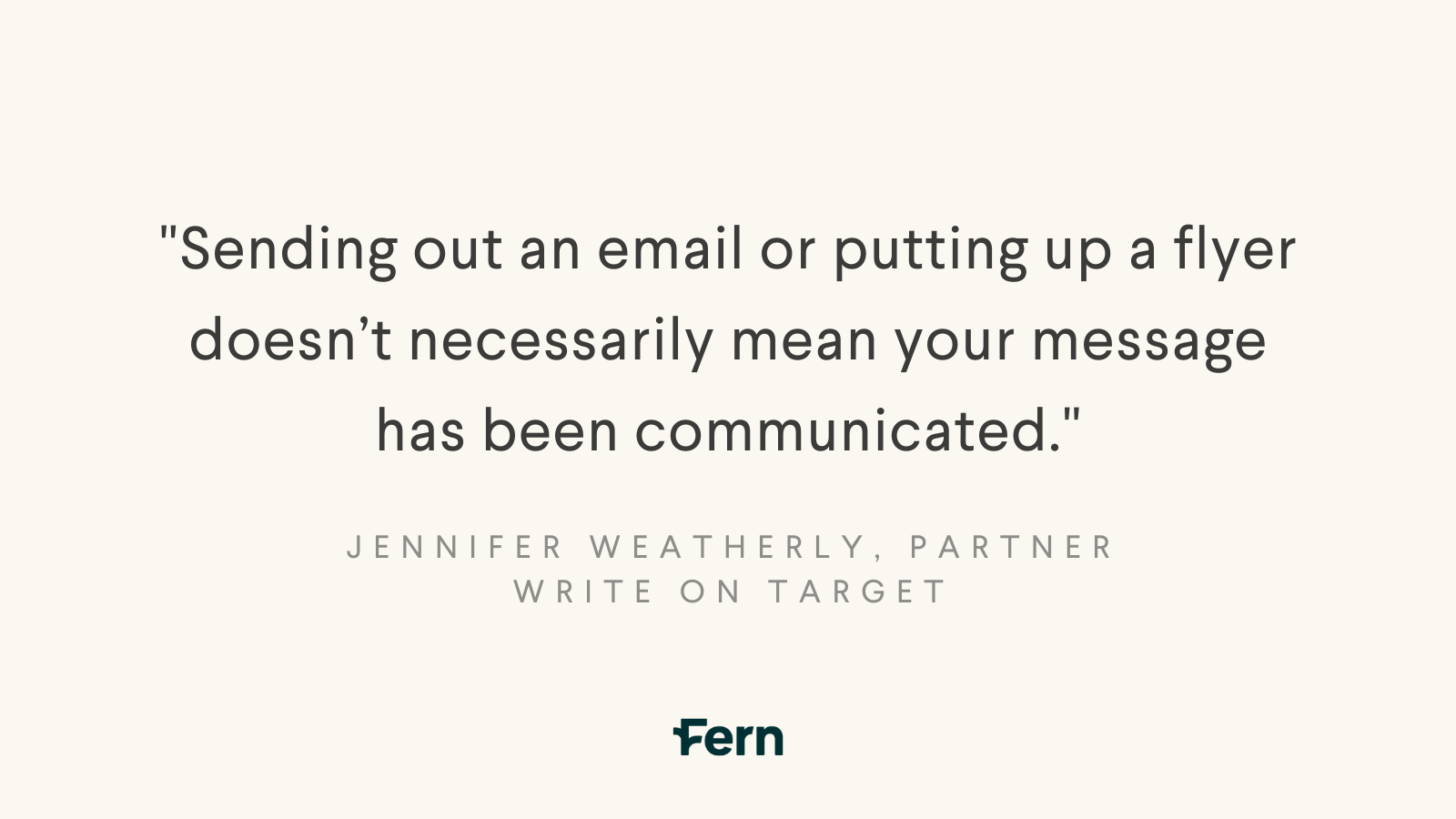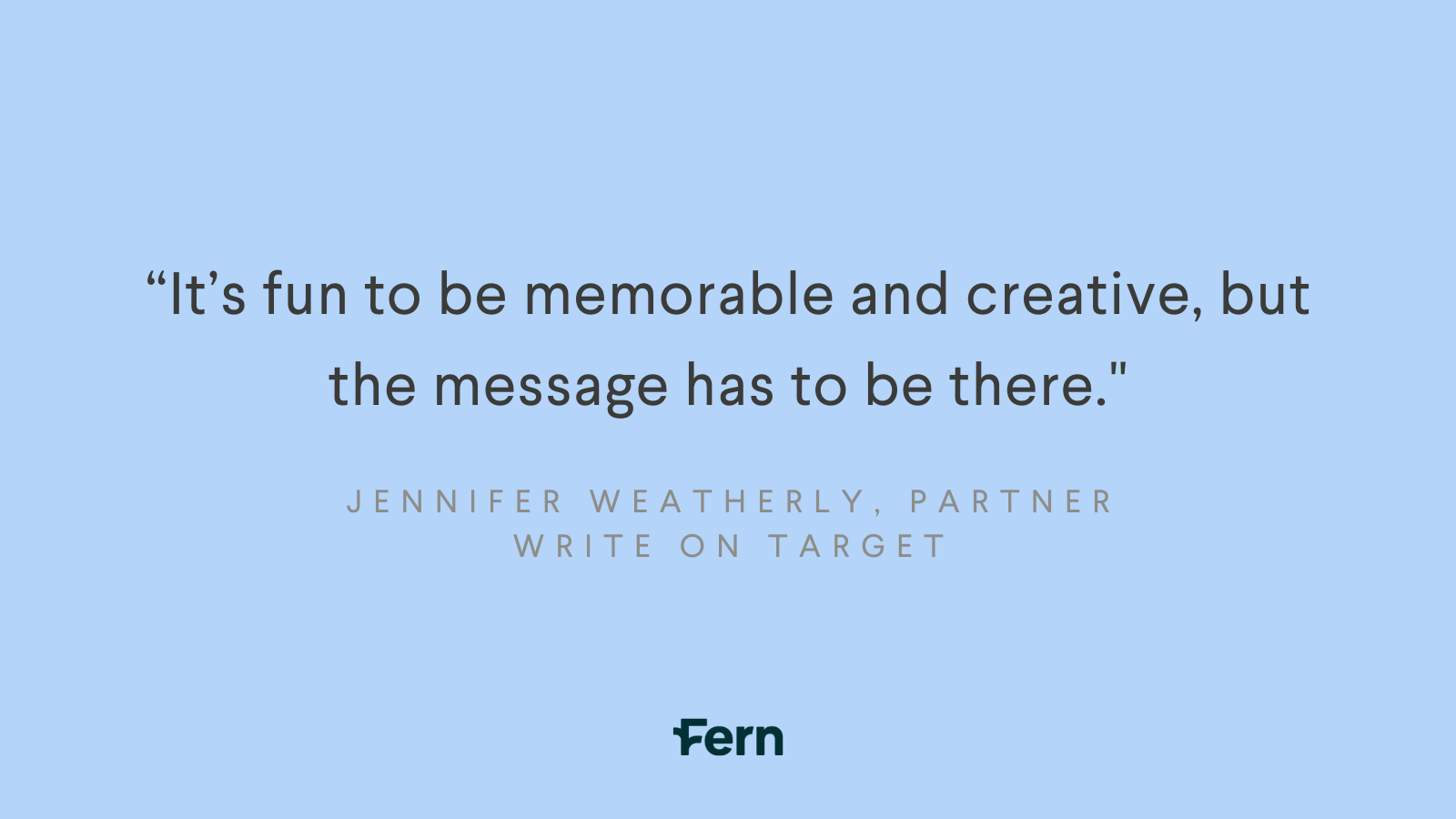There are more employee benefits communication channels open to HR teams than ever. Email, text messages, webinars, virtual and on-site benefits fairs – the list of creative options goes on.
But before you get too creative and hire a skywriter to promote your new wellness program, there are important steps to take first – or risk your messages getting lost in the noise.
“It’s fun to be memorable and creative, but the message has to be there,” says Jennifer Weatherly, Partner of Write On Target, an HR communications firm that’s been supporting the efforts of Fortune 500 companies for more than 25 years.
She shared some of the most common mistakes she’s seen clients make over the years, and how benefits leaders can adjust their approach to make sure their messages land.
1. The mistake: Starting your communications plan with tactics.
The fix: For some, designing the creative might be the fun part. But before you start researching color schemes and photos for your flyer, focus on message, timing, and then channel.
“You don’t want to add to the noise, so you want to communicate something that adds value to the person who’s receiving it,” says Weatherly. “Figure out the message first, then decide how to package it.”
What problem does your benefit solve for employees? Before creating materials, focus on why employees should care about the new benefit.
And remember that sharing information once is rarely enough. Marketers follow a rule first posited in the 1930s that most people need to see something seven times before they remember it. When building your plan, list out multiple channels you can use to promote your benefit, and the timing that fits each best.
“Sending out an email or putting up a flyer doesn’t necessarily mean your message has been communicated,” says Weatherly.
2. The mistake: Your timing is off.
The fix: Reduce competition and communicate employee benefits at the “point of purchase.”
Remember that you’re competing for attention with everything else going on in your employees’ lives.
Sending an email out on a Friday afternoon or evening, for example, typically isn’t ideal, especially if you’re about to enjoy a three-day weekend.
Recently, other employee benefits communications have had to compete with urgent matters. Important information like office reopening plans, COVID-19 testing, and vaccine availability take priority.
Instead, create separate announcements for a new program. Or, tie your employee benefits offering with a timely event.
For example, many employees have been dealing with musculoskeletal pain during the pandemic due to stress and uncomfortable at-home work stations. Highlight how an employee benefit can help employees with a problem they’re facing right now.
Weatherly also suggests communicating employee benefits at the “point of purchase,” or when someone is most likely to take action. She’s seen point-of-purchase communications work well for age-related milestones. For example, send a birthday card with a message around adding more to your 401K as the employee gets closer to retirement age. The more relevant you can make your employee benefit communications, the more likely it is that someone will take action.

3. The mistake: You’re not talking about benefits frequently enough.
The fix: Every HR conversation is an opportunity to talk about benefits, says Weatherly.
“Every time an HR person goes into a meeting is a prime opportunity to talk about something or promote something, even if it’s just a ten second spiel,” says Weatherly.
Small promotions add up and help make programs memorable. Weatherly suggests using the signature line in your email to promote new benefits or deadlines.
You can also place communications in areas that someone might already associate with the benefit. For example, promote a healthy eating benefit in the cafeteria. Post signs about pain support in an area where workers are lifting boxes or completing other repetitive tasks.
4. The mistake: Making assumptions about communication preferences.
The fix: Test new ideas on a smaller scale when possible.
You may assume that younger generations would prefer to receive updates through text messages rather than email or print materials. But Write On Target has found that many younger employees don’t want to hear from their employer via channels that feel personal. Deskless workers in particular prefer not to hear from work after they’ve clocked out for the day, Weatherly says.
When you can, conduct a short survey or run a small test before starting a new communications channel. Keeping up internal communications like newsletters, text messages, and internal message boards all take time, so make sure it will be worth the effort first.
Another common mistake? Continuing to use channels and tactics that aren’t clicking for your employees.
“Let’s say you have something to communicate, so you send out an email, and no one reacts,” says Weatherly. “So you send out another email. Nothing. So you send out three more. But maybe that’s just not the best way to communicate.”
While testing new subject lines and the time of day you send communications can help, sometimes a certain channel simply isn’t the best way to communicate your message. The message matters more than the medium. Don’t fall in love with your flyer! Keep testing until you find the best medium for your message.
5. The mistake: Overwhelming employees with options.
The fix: Bundle together solutions that go together, like physical health and mental health.
If your company offers a myriad of benefits, while perhaps a good problem to have, employees can feel overwhelmed. Choice overload is a psychological phenomenon that can paralyze someone so much that they ultimately choose nothing.
One way to help? Group together similar benefits so they’re easier to digest. For example, group together solutions you have for managing chronic conditions, physical fitness, or mental health. Organizing your solutions by the problems they solve, rather than by name, can help contextualize them for your employees.

6. The mistake: Casting too wide of a net in your promotions.
The fix: Work closely with managers and other service providers to target your programs to those they’ll benefit most.
While some employee benefits can help all or most of your employees, some are more specific – and may touch on sensitive subjects.
For mental health services, for example, train managers on signs that someone might benefit from the program. Include training on how to approach employees about a sensitive topic in a tactful way, too.
Whenever possible, integrate your employee benefits with each other, as well. Someone receiving care for one condition may receive a referral to your Employee Assistance Program (EAP) if they screen for depression and anxiety, for example.
For benefits like corporate chronic pain programs, other medical services such as on-site clinics can be helpful referral points. If you have on-site clinics, make sure the team there knows about all of your offerings and the requirements to participate in each. Meeting people where they are and training your staff on what to look for can help identify employees most likely to benefit from a particular program.
7. The mistake: Forgetting about the power of word of mouth.
The fix: Use in-person meetings to promote benefits whenever possible.
Word of mouth, in person meetings, manager support – these remain the most reliably impactful communication channels, and they also happen to be the most low tech.
“The only one thing that works for everybody is an in-person meeting,” Weatherly says. “Every age group wants that.”
While your HR team may not have the bandwidth to meet with every employee to discuss all of your offerings, think about where you can take advantage of other in-person meetings. Managers can discuss employee benefit offerings during team huddles. And again, any meeting that includes HR can also add in plugs for employee benefits you’re trying to increase awareness around.
Employee benefits communications that stick
Creativity and clever messaging can help employee benefits communications stick in employees’ minds. But if you skip over your core message straight to the “fun part,” your messaging may ultimately fall flat.
Weatherly says she often thinks of this George Bernard Shaw quote when consulting with clients: “The single biggest problem in communication is the illusion that it has taken place.”
By sending the right message, at the right time, in the right place, you can help make sure your communications land and offer your employees the support they’re looking for from their employee benefits – no matter how they hear about them.






